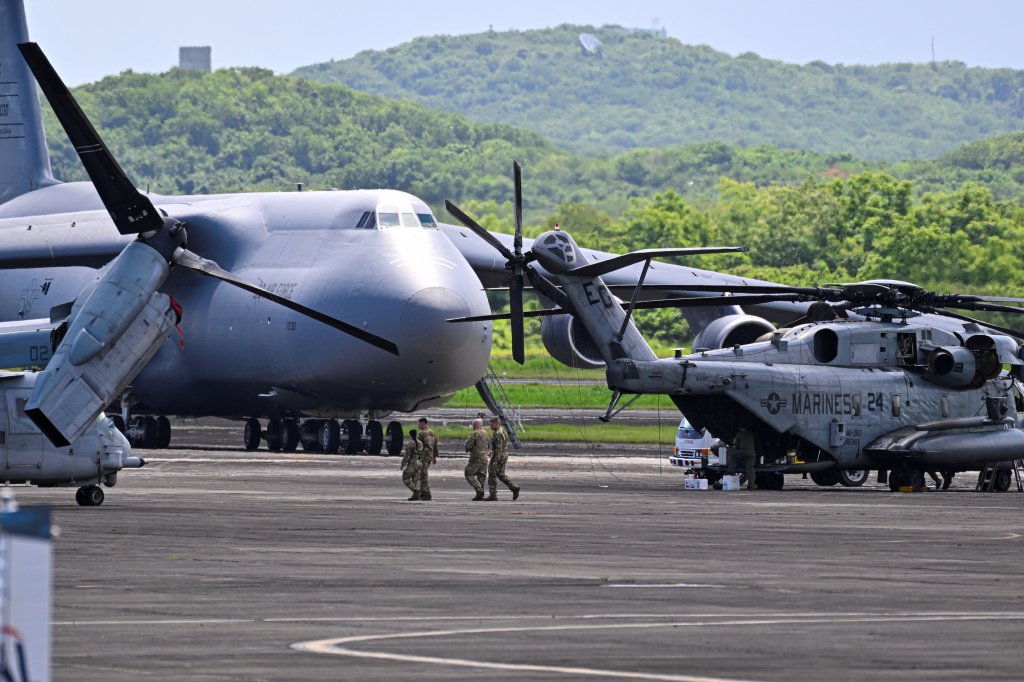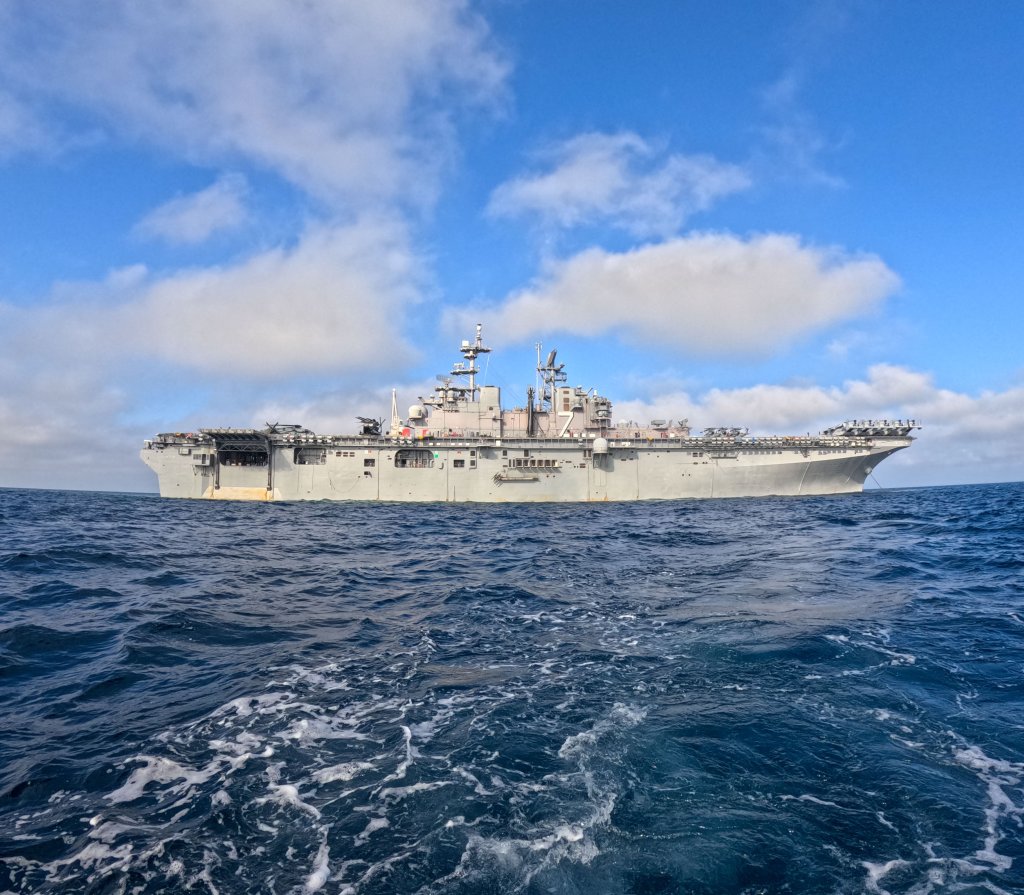Historic Shuttered Navy Base Back In Action For Caribbean Counter-Drug Mission
The F-35B stealth fighters that landed in Puerto Rico on Saturday joined a growing U.S. military presence at the former Naval Station Roosevelt Roads. Though the Navy disposed of this sprawling facility more than two decades ago, it is now a major staging area for the Trump administration’s battle against narco traffickers and pressure campaign against Venezuelan dictator Nicolas Maduro. These counter-drug activities have some asking whether Roosevelt Roads, once considered surplus by the U.S. Navy, should be permanently reopened as a military installation.
Before the F-35s arrived, cargo aircraft like the C-5 Galaxy and C-17 Globemaster III were seen at the facility, now known as José Aponte de la Torre Airport. There were also U.S. Marine Corps MV-22 Osprey tilt-rotor aircraft and USMC CH-53K King Stallion helicopters present. The Marine aircraft are part of the Iwo Jima Amphibious Readiness Group (ARG) and the 22nd Marine Expeditionary Unit, which began a training exercise on Puerto Rico on August 31.

In addition to the aircraft, images showed U.S. Air Force personnel restoring the airport communications control tower, while others loaded and unloaded cargo and prepared for future operations.
Though images emerging on social media showed MQ-9 Reaper drones at Rafael Hernández Airport on the other side of the island, open-source flight tracking data points to at least one possibly operating out of Roosevelt Roads. It is believed that a Reaper was used to destroy what Trump said was a cartel drug boat with 11 people and a load of narcotics.
All this activity is taking place as the U.S. is once again turning to Roosevelt Roads, which had provided support for America’s invasions of the Dominican Republic, Haiti, Grenada and Panama in decades past. While there are other facilities on the island also taking part, Roosevelt Roads has become a nexus of activity for this effort.
The 8,650-acre facility, located in the easternmost point of Puerto Rico’s main island in the town of Cieba, was opened in 1943. Its centerpiece is an 11,000-foot runway capable of supporting the U.S. military’s inventory of aircraft.

Roosevelt Roads also has a deep-water port enabling the Navy’s surface and subsurface vessels to dock.


The concept of a military facility on the eastern part of Puerto Rico began in 1919, when Franklin Delano Roosevelt, then Assistant Navy Secretary, conducted a surveying trip to the area. The future president saw the location as a strategic asset in the Caribbean. But Roosevelt’s vision would not become a reality for another three decades.
The base was first built during World War II and named for Roosevelt, who came up with the concept. The initial plan was that it would become the keystone of U.S. defenses in the Caribbean, “with a well-protected anchorage, a major air station and an industrial establishment capable of supporting 60 percent of the Atlantic Fleet under wartime conditions,” according to GlobalSecurity.org. “There were even rumors that if the British Empire ever fell to Axis powers, Roosevelt Roads would become the new operating base for the British Fleet.”
However, with the U.S. military’s efforts focused on Europe and the Pacific, the Navy put expansion plans for the base on hold. In 1957, during the height of the Cold War, Roosevelt Roads was redesignated as a Naval Station. With the Soviet Union-aligned Cuba perceived as a growing threat, the facility’s footprint on the island began to grow. Its port facilities made the base a major support facility for the Sixth Fleet.

After two terrorist attacks on the island damaged equipment at another location, the Naval Communications Station Puerto Rico was relocated to a new, state-of-the-art communications facility at Naval Station Roosevelt Roads because it was considered far more secure.
The station “would eventually become one of the largest naval facilities in the world, encompassing more than 100 miles of paved interior roads,” according to the Navy. However, in the early 2000s, its future grew cloudy.

The facility’s main mission was serving as a coordinating facility and mission staging point for the U.S. Navy’s bombing range on the island municipality of Vieques, about 10 miles to the southeast. The bombardments were carried out for six decades and generated massive protests over civilian deaths and environmental destruction.
The base was also home to Fleet Composite Squadron Eight (VC-8), the Navy’s last operator of the A-4 Skyhawk. The unit began operations there in 1965 and became the last Navy squadron based at Roosevelt Roads. The unit provided training assistance through acting as aggressors and towing targets, among other roles, for units visiting the Caribbean outpost. The Navy’s maritime patrol operations were also a major presence at the base.

The Navy finally ended the bombing in 2003. With the Vieques bombing range closed, the Navy also decided it no longer needed Roosevelt Roads or its units there. It was proposed to be closed under the Base Realignment & Closure (BRAC) process used to dispose of unwanted U.S. military installations. By that time, just two years after 9/11, the U.S. had rapidly shifted its focus to the global war on terror.
Without Vieques, Roosevelt Roads was considered obsolete,” Federico de Jesus, a former director of the Puerto Rico Federal Affairs Administration, told us.
As part of the Navy’s turnover of Roosevelt Roads to Puerto Rico, it transferred thousands of housing units, schools, utilities and a world-class hospital that were on the facility. The closure was welcomed by many in Puerto Rico who were opposed to the militarization of the island. However, that move also raised concerns about the loss of a huge economic driver.
After the base was shuttered, various parts of it were turned over to different Puerto Rican government organizations. Given its location, there have been efforts over the years to develop parts of Roosevelt Roads; however, those plans remain in flux.

Despite the closure, the U.S. continued to use the installation for contingencies and relief efforts, like the November 2017 missions to provide much-needed aid in the wake of Hurricane Maria, which devastated the island.

The U.S. Navy began reusing Roosevelt Roads at a much larger scale on Aug. 31 to support training operations by the Iwo Jima Amphibious Readiness Group (ARG)/22nd MEU. Operations at the base have since expanded.
Despite the facility’s ability to support the Trump administration’s current efforts, the Navy has no plans to permanently use Roosevelt Roads, a U.S. defense official told The War Zone.
However, there is an effort in Puerto Rico to re-establish the facility as a working military installation.
Two weeks ago, New Progressive Party of Puerto Rico Sens. Nitza Morán Trinidad and Carmelo Ríos Santiago “introduced Senate Resolution 286, which calls for an investigation into the current state of the former Roosevelt Roads naval base in Ceiba,” the San Juan Daily Star reported last week. “The measure aims to evaluate the feasibility and impact of potentially repurposing Roosevelt Roads for national security by the Army.”
“For decades, Roosevelt Roads represented an economic engine for the eastern region of the island,” Morán Trinidad said, according to the publication. “Today, we have a responsibility to seriously and strategically consider the possibility of its facilities once again playing a key role — not only in the defense of the Caribbean and the Americas but also in the economic revitalization of Ceiba and the surrounding municipalities.”
The future of that effort, however, remains unclear.
With the Trump administration giving no timeline for its Caribbean operation, it looks like Roosevelt Roads will continue to be a very active facility for the U.S. military in the short term. However, given the administration’s focus on Central and South America, it’s quite possible that larger plans for the installation could materialize. Regardless, at least for now, Roosevelt Roads has woken up from its long slumber.
Contact the author: [email protected]


